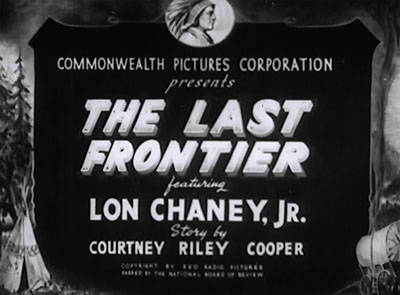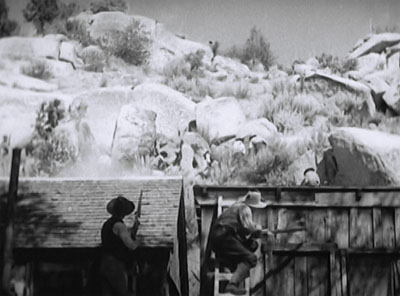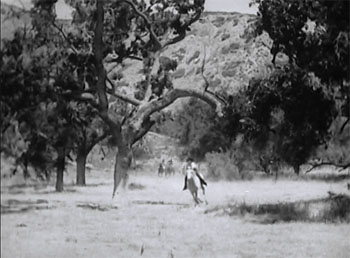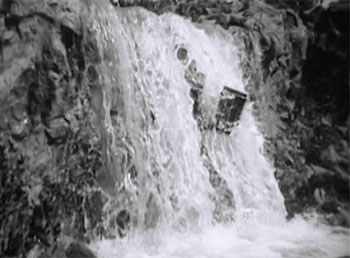
RKO, 12 Chapters, 1932. Starring Lon Chaney Jr., Dorothy Gulliver, Francis X. Bushman Jr., Richard Neill, Judith Barrie, Slim Cole, Mary Jo Desmond, LeRoy Mason, Claude Payton.
The unctuously respectable trader Lige Morris (Richard Neill) and his partner Jeff Maitland (Francis X. Bushman Jr.) are secretly selling guns to a hostile tribe of Pawnees–and are encouraging the armed Indians to drive everyone from the frontier town of Morrisville, which will allow Morris and Maitland to gain control of the gold-rich surrounding territory. Morrisville newspaper editor Tom Kirby (Lon Chaney Jr.), frustrated by the Army’s failure to stop the gun-running, does battle with Morris’s henchmen himself–frequently adopting the guise of the mysterious “Black Ghost” in his fight against the gang; he’s aided by Betty Haliday (Dorothy Gulliver), the spunky daughter of an Army colonel, and also receives unexpected assistance from Maitland’s worried wife Rose (Judith Barrie), who desperately wants her husband to abandon his partnership with Morris before it’s too late.


Above left: An indignant editorial by Tom Kirby is indignantly discussed by General Custer (William Desmond, in buckskin shirt) and Colonel Haliday (Claude Payton) at above right.
RKO Pictures, the distributor of The Last Frontier, was the only one of Hollywood’s “Big Five” studios to release a serial during the sound era–but they didn’t actually produce the one talking chapterplay that bore their imprint; instead, they farmed out its production to Amedee “Andy” Van Beuren, an independent producer who supplied RKO with cartoons, live-action shorts, and documentaries that played alongside the big studio’s features. Van Beuren in turn assigned his shorts producer Fred McConnell to oversee Frontier; McConnell, who’d worked in various capacities on silent serials for Universal and the Pathé Exchange, was able to recruit several former employees of the now-defunct Pathé to assist him in assembling his new chapterplay, among them directors Spencer Bennet and Thomas Storey and cameraman Edward Snyder. McConnell also hired screenwriters George Plympton and Robert Hill, who had worked on Universal’s serials in the silent days and would remain in the chapterplay game during the sound era (as, of course, would director Bennet).
The resources that this capable team were given to work with, however, were not comparable to those they’d enjoyed at Universal or Pathé–although Frontier’s budget was obviously higher than those of independent serials produced without any big-studio backing; its camerawork (by Snyder and Gilbert Warrenton) is fluid enough, its sets respectable enough, its extras numerous enough, and its locations varied enough to keep it from looking as cheap or as static as many of the said independents did. However, while on a superficial level Frontier appears to be about on a production par with a contemporary Mascot effort, it’s a good deal more slipshod in the action and photography departments than most Mascots were. Similarly, though it resembles most of Universal’s Western serials in its basic plotline (a simple saga of hardy frontiersmen battling outlaws and Indians), its major plot points are much more hazily-defined than they would have been in a Universal effort.
One example of Frontier’s vague plotting is provided by its treatment of the villains; their overarching scheme is never explained fully in any one sequence, leaving the viewer to mentally connect the dots between widely scattered scenes in order to get a clear idea of the extent of Morris and Maitland’s plans. The motives for Tom Kirby’s Black Ghost masquerade are even more hazy; in fact, they’re left completely unexplained (probably thanks to meddling by producer McConnell–see the note at the end). There’s absolutely no narrative need for the masquerade, since, like many of Republic’s masked men, Kirby behaves just as heroically in both identities; unlike most of the Republic heroes, he doesn’t even have the excuse of family tradition to motivate his disguise. I use the term “disguise” loosely, since Kirby wears no mask as the Ghost, instead concealing his identity with nothing more mystifying than sideburns, a small moustache, a black caballero outfit, and a Mexican accent–which seem to have the same magical mind-fogging powers that Clark Kent’s glasses would later display.

Above: Lon Chaney Jr.’s Tom Kirby in his Black Ghost “disguise.”
Haziness often surrounds Frontier’s minor plot points as well its major ones, with characters frequently making abrupt and unexplained appearances to keep the story moving (like heroine Betty in Chapter Nine and sidekick Happy in Chapter Ten). The Chapter Three aftermath of the Chapter Two buffalo-stampede cliffhanger is even more jarring; the hero and heroine’s escape takes place off-screen and is only belatedly and briefly described–as is the heroine’s subsequent capture by Indians, further compounding the confusion of the whole sequence. It’s also hard to figure out why the heroine doesn’t provide the wounded hero with immediate aid in Chapter Four, or why Morris suddenly decides to dress up as the Black Ghost himself in the final chapter; the suddenness with which false gun-running charges are hurled at Kirby in Chapter Five (and the equal suddenness with which they’re dropped in Chapter Eight) is more than a bit perplexing as well.

Above: Hero and heroine are about to be run down by buffalo (the impressive footage is derived from a silent feature; see below).
However, the framing-of-the-hero subplot (as in many Mascot serials) does provide some welcome narrative variety; in fact, disjointed as it frequently is, the storyline of Frontier contains enough incident and changes its direction often to avoid seeming excessively slow or repetitious. The first four episodes center around a tug-of-war over one of the villains’ rifle shipments, while the next three episodes deal with the efforts of Betty and Rose Maitland to prevent the wounded Kirby from being arrested and then with Kirby’s attempt to rescue Betty from the outlaws. In Chapter Eight, the previously-secret gold deposits are discovered and the villains launch an all-out attack to stop the ensuing gold-rush; this attack causes an incident that leads to a break between Morris and Maitland, the repercussions of which drive most of the action in the remaining episodes.

Above: The battle at the gold mine that launches the final phase of the serial’s plot.
The storyline of Frontier could have seemed even less repetitive had a few subplots been better-developed–if, for example, Morris’ deception of the Pawnee chief had eventually been discovered by the Indians, or if Maitland’s apparent attempt to win the trust of the Colonel and Betty by paying polite court to the latter (after making his wife Rose pose as his sister) had continued for a little longer; instead, the latter subplot is entirely forgotten after Chapter Four, and has no real effect on the story or on Betty’s conflicting romantic interests in both Kirby and the Black Ghost (another underdeveloped subplot). However, the conflict between the villainous Maitland and the loving but villainy-hating Rose (a very unusual plot device for a serial) is used to good and interesting effect throughout, playing a crucial part in the plot at several points.
The action scenes in Frontier have the same ragged quality as much of the plotting, even with Bennet co-directing and Yakima Canutt handling some of the stuntwork. The serial’s numerous horseback chases across the scenic landscapes of Kernville and another area that looks as if it might be Universal’s ranch locations are frequently exciting and contain some striking shots–particularly the ones in Chapters One and Ten–but are also frequently marred by distractingly shaky camerawork and by excessive intercutting that hurts the flow of the action; the periodic use of painfully fake-looking “riding” inserts of the principals also hurts many of the horseback scenes (that same Chapter One sequence and the Chapter Eleven chase scene both provide examples of these problems). Canutt (doubling Dorothy Gulliver!) does provide a thrilling conclusion to the Chapter Eleven chase, by performing his classic fall-under-the-wagon stunt; the direction and editing come to his aid here, with good close-ups of Gulliver–clinging desperately to the wagon-tongue and (seemingly) surrounded by the galloping hooves of the wagon team–making the sequence look convincing, despite the very obvious doubling when the actual fall comes.




Above, top left and right: Two good shots from the Chapter One chase sequence, one (left) depicting Lon Chaney Jr. on a horse at Kernville and one showing Dorothy Gulliver fleeing from Indians at (possibly) the Universal ranch. Bottom left and right: Two bad shots from the same sequence–a hokey one of Gulliver pretending to ride a horse, and a choppy and shaky one that’s supposed to show Gulliver and Chaney trying to keep their seat on a rearing steed.
Similar (but different) close-ups of Gulliver holding tightly to a wagon-tongue are used to equally good effect during the Chapter Two wagon-chase sequence, which features a neat variation on the wagon-team stunt; this time, Canutt (doubling Lon Chaney Jr.) leaps onto the team and hauls Gulliver’s double (possibly Ken Cooper) back to the safety of the wagon seat. These and other equestrian stunts seem to represent Canutt’s chief contributions to the serial; while he substitutes for leading man Chaney to perform some good leaps out of trees (the most impressive being the one in Chapter Ten) and off of roofs (scaling a Kernville cabin to surprise a villain in Chapter Four), he doesn’t appear during the serial’s fight scenes.


Above left: Dorothy Gulliver holds on to the wagon-tongue for dear life. Above right: Yakima Canutt jumps from his horse to the runaway team. Both shots are from the Chapter Two sequence described above.
Instead of Canutt, Chaney himself can be clearly seen doing his own slugging, flipping, and jumping in the fight sequences, while his villainous opponents–chief among them the powerful Joe Bonomo–are likewise undoubled. Said fistfights are pretty clumsy-looking at times, particularly the confused melee in the storeroom in Chapter Twelve–but are also quite energetic, featuring some entertainingly vigorous kicks, leaps, and falls, as well as some of the vivid furniture-smashing common to so many Bennet-directed serials. The lengthy, slam-bang Chapter Seven cabin fight between Chaney and Bonomo (who demolish most of the building’s interior) is especially exhilarating, while the Chapter Eight office fight (which concludes with Bonomo flying backwards out of a window) is well-done too; the Chapter Twelve office fight between Chaney and LeRoy Mason is also good, but much briefer.


Above left: Lon Chaney Jr. kicks Joe Bonomo off his chest during the Chapter Seven cabin fight. Above right: Bonomo and Chaney topple a pot-bellied stove during the same fight.
The novel Chapter Two chase along the Kernville river (with Chaney on horseback keeping up a running fire at canoeing villains) is another of the serial’s better action scenes, as is Chapter Four’s fight on a raft in the same river; the large-scale gun battle at the gold mine in Chapters Nine and Ten is a standout too. This last-named scene is the biggest sequence actually filmed for the serial; other big battles–like the Indian attacks on wagon trains in Chapters Three and Eleven–are derived almost entirely from the big-budgeted 1926 silent feature The Last Frontier (see the note at the end for further details). These undercranked stock shots, like the silent Indian-attack sequences featured in innumerable Universal sound serials, are rarely incorporated smoothly into the chapterplay–although the attack on the town in Chapter Three, after some poor matchups at the start, does a fair job of blending old and new scenes. The old footage itself, though frequently obtrusive, is very impressive; it’s also refreshing to see a set of Indian stock shots completely different from the footage so heavily overused in Universal’s outings.




Above, top left: Chaney takes aim at the villains’ canoe in Chapter Two. Above, top right: A long-shot view of the Chapter Four tussle on the raft. Bottom left: Stock-footage Indians gallop through the wilds, arriving in Morrisville via new footage at bottom right.
Shots from the silent Last Frontier also provide the serial’s buffalo-stampede sequences, including the one that the above-mentioned Chapter Two cliffhanger is centered around; poor though the resolution is, the sequence itself is quite striking. The over-the-falls cliffhanger of Chapter Six features some embarrassing close-ups of toy-like miniatures, although the sequence also incorporates more good Kernville river footage and several fine shots of a real waterfall. Some of the serial’s better cliffhangers include the previously-referenced Chapter Eleven fall under the wagon-team, the Chapter Ten sequence that has a lassoed Dorothy Gulliver and Lon Chaney dangling from a cliff, the intense cabin fire at the end of Chapter Seven, Gulliver’s engulfment by quicksand in Chapter Five, and her cleverly-orchestrated accidental shooting of Chaney that concludes Chapter Four. The Chapter Nine stagecoach crash, in which chaotic camerawork is used to far better and more appropriate effect than at other points in the serial, is also a standout, although (like the waterfall cliffhanger and the Chapter Eight mine explosion) it features an unlikely live-through-it resolution.


Above: A raft with the hero and heroine aboard goes over the falls in Chapter Six (left), while a cabin containing them burns up in Chapter Seven (right).
The cast of Last Frontier is an engaging one, its members displaying the same combination of early-talkie awkwardness and likably hammy earnestness that made the acting in the early Mascot serials so fascinating. Lon Chaney Jr., billed as Creighton Chaney in original prints of the serial, is almost shockingly slim and athletic-looking in one of his first roles; his acting is a little stiff at times (especially when he’s trying to deliver lines in the Black Ghost’s horribly bogus-sounding accent), but for the most part he carries himself well, displaying an energetic confidence that’s sometimes over-theatrical but is quite appealing. He growls commandingly and ferociously at heavies, laughs heartily at their discomfort, reacts with feverish alarm when those close to him are threatened, and conveys amused affection when flirting with the heroine in his Ghost guise.
As the aforesaid heroine, the lovely Dorothy Gulliver takes nearly as big a share of screen time as Chaney does, continually rushing into danger with a determined but breathlessly excited air. As in her Mascot outings, her acting is often delightfully vivacious (as when she exuberantly chats with Chaney and Claude Payton in her first dialogue scene, or when she reacts silently to a kiss from the Black Ghost), but is remarkably wooden in other scenes (like the one in which she tells the Black Ghost that she loves his alter ego Tom Kirby, after the Ghost has declared his love for her); her unfailing sincerity, however, makes these amateurish lapses seem just as endearing as her more focused moments.
Judith Barrie, who both looks and sounds something like a blonde Anne Rutherford, is excellent as the long-suffering Rose Maitland, turning in a moving and emotional performance without ever seeming whiny or hysterical; her heart-broken weeping in her Chapter Six confrontation with her bullying husband makes the scene almost painful to watch. In the difficult role of Jeff Maitland, Francis X. Bushman Jr. is fine when he’s assuming a genial pose, and does a good job of seeming weakly mendacious when he’s trying to convince his wife that everything will be fine–but he’s so harshly and enthusiastically nasty when he’s threatening people or plotting crimes that it’s hard for us to share any of his wife’s concern for him. When his character eventually begins to repent in the final third of the serial, Bushman does try hard to make his expressions of bitter regret seem impassioned, but just can’t summon up the intensity needed to really put them across.

Above: Francis X. Bushman Jr. and Judith Barrie.
Richard Neill is outrageously (and memorably) hammy as the serial’s top-ranking villain, the scheming and hypocritical Morris. His oily, feignedly meek rebukes of outspoken soldiers or townsmen (“Brothers, let us do nothing hasty”) his complacent sneers when concocting plots, his harsh snarling when crossed (“I’ll beat them all!”), and his perpetual hand-rubbing make him the very picture of the stereotypical stage-melodrama villain; one expects him to start foreclosing widows’ mortgages at any moment. His characterization is fully as cartoonish as it sounds, but it’s thoroughly entertaining at the same time.

Above: Richard Neill (left) gloats over good news received from Fred Burns.
The bearded, bass-voiced, and imposingly tall Charles “Slim” Cole–a stuntman and silent-era character player–is pleasantly colorful as Happy, Tom Kirby’s printer and sidekick; though he’s extremely quirky–spending a lot of his time doing vocal imitations of ghosts, roosters, buzz-saws, bugles, coyotes, and so forth–he also comes off as a dependable rough-and-tumble frontiersman, not a brainless idiot. Child actress Mary Jo Desmond (William Desmond’s daughter) gives a fine performance as Aggie, Kirby’s adopted daughter and Happy’s inseparable crony; her admiring attentiveness to Happy’s imitations and tale-spinning, and her calm but quietly resolute (and usually successful) efforts to assist Happy and Kirby add a charming touch to the serial. However, the flashback sequence describing Kirby’s long-ago rescue of Aggie after her family’s massacre by Indians really should have come early in the serial, in order to give young Miss Desmond’s character a proper introduction; instead–in another example of Frontier’s narrative sloppiness–it’s deferred until Chapter Eight, when the main plot stops dead for Happy to narrate the flashback.

Above: Mary Jo Desmond and Slim Cole.
LeRoy Mason has his first serial role as Buck, Neill and Bushman’s lead henchman; he’s kept in the background for most of the serial, performing a fair share of villainy but receiving comparatively few lines. However, he’s given brief opportunities to display his familiar cool craftiness when he makes terms with the Indian chief early in the serial, and when he plots with Neill against Bushman later in the proceedings. The back-up henchmen are a formidably tough-looking lot: hulking strongman Joe Bonomo, former rodeo-rider and cowboy star Pete Morrison, stuntmen/wranglers Tommy Coates and Ben Corbett, and the grizzled old lassoing champion Fred Burns–who memorably demonstrates his roping prowess as part of the Chapter Ten lassoing cliffhanger.

Above: Pete Morrison (left) and LeRoy Mason chortle evilly as they pole their raft downstream.
Claude Payton, as Dorothy Gulliver’s army-colonel father, registers parental concern, stern indignation, and military authoritativeness in robustly stagy style; William Desmond is equally stagy as Payton’s superior–General Custer himself–but only appears in a couple of scenes in the first episode. Yakima Canutt has a couple of walk-ons as Custer’s daring scout Wild Bill (Hickok, presumably, though his last name isn’t mentioned). Fritzi Fern plays Chaney’s Indian housekeeper, and Frank Lackteen makes periodic appearances as the hostile chief Pawnee Blood–grimly negotiating with the villains, and providing a handy visual link to the stock footage from the silent Last Frontier, in which he also played an Indian leader; the scenes of him rallying and leading his tribesmen are all borrowed from the earlier release.
The basically sound but highly disorganized storyline and the lively but often irregular action scenes in The Last Frontier ultimately make the serial seem like the rough draft of a chapterplay that would have been quite strong, had it ever made it to “finished” form. Disconcertingly erratic as it often is, it’s also entertaining enough to make one wish that RKO had decided to allot Van Beuren and McConnell’s production team a little more money, and had then instructed them to try their collective hand at a few more serials.

Above: Yakima Canutt, doubling Lon Chaney Jr., leaps from a tree to surprise Ben Corbett.
A note on the source material: The Last Frontier was officially based on a novel of the same name by Courtney Ryley Cooper; this book had also been the source of the 1926 Last Frontier feature, and was undoubtedly selected for serial treatment by Van Beuren and McConnell because RKO held the rights to the 1926 film, allowing the chapterplay (as mentioned above) to plunder it for stock footage. Someone involved in the production of the Frontier serial decided to transform the scout hero of the book (and the silent film) into a fighting newspaper editor with a dual identity; this idea was almost certainly contributed by McConnell, who’d worked on the silent serial The Return of the Riddle Rider–a sequel to Universal’s phenomenally popular chapterplay The Riddle Rider; both serials featured a Western newspaperman who doubled as a costumed avenger. Judging from the clumsy way that the Black Ghost business is shoehorned into Frontier, it would seem that McConnell ordered the writers to incorporate it at a fairly late stage of writing, presumably hoping to catch and bottle a little of the Riddle Rider chapterplays’ lightning.
Acknowledgements: I’m greatly obliged to my friend Ed Hulse–author, magazine editor, and serial expert par excellence–for providing me with the information included in the above note, and with much of the production history referenced in the main review. You can read about Ed’s books on silent serials (jam-packed with much more info of this sort) on his website, Murania Press.


Excellent review. Loved the stock footage in this one, and Chaney and Gulliver made a very attractive pair of leads. Chaney’s phony accent didn’t bother me as he wasn’t a real Hispanic but an Anglo putting on a phony accent. I agree very erratic, but for me the good points outweigh the bad. *** out of *****